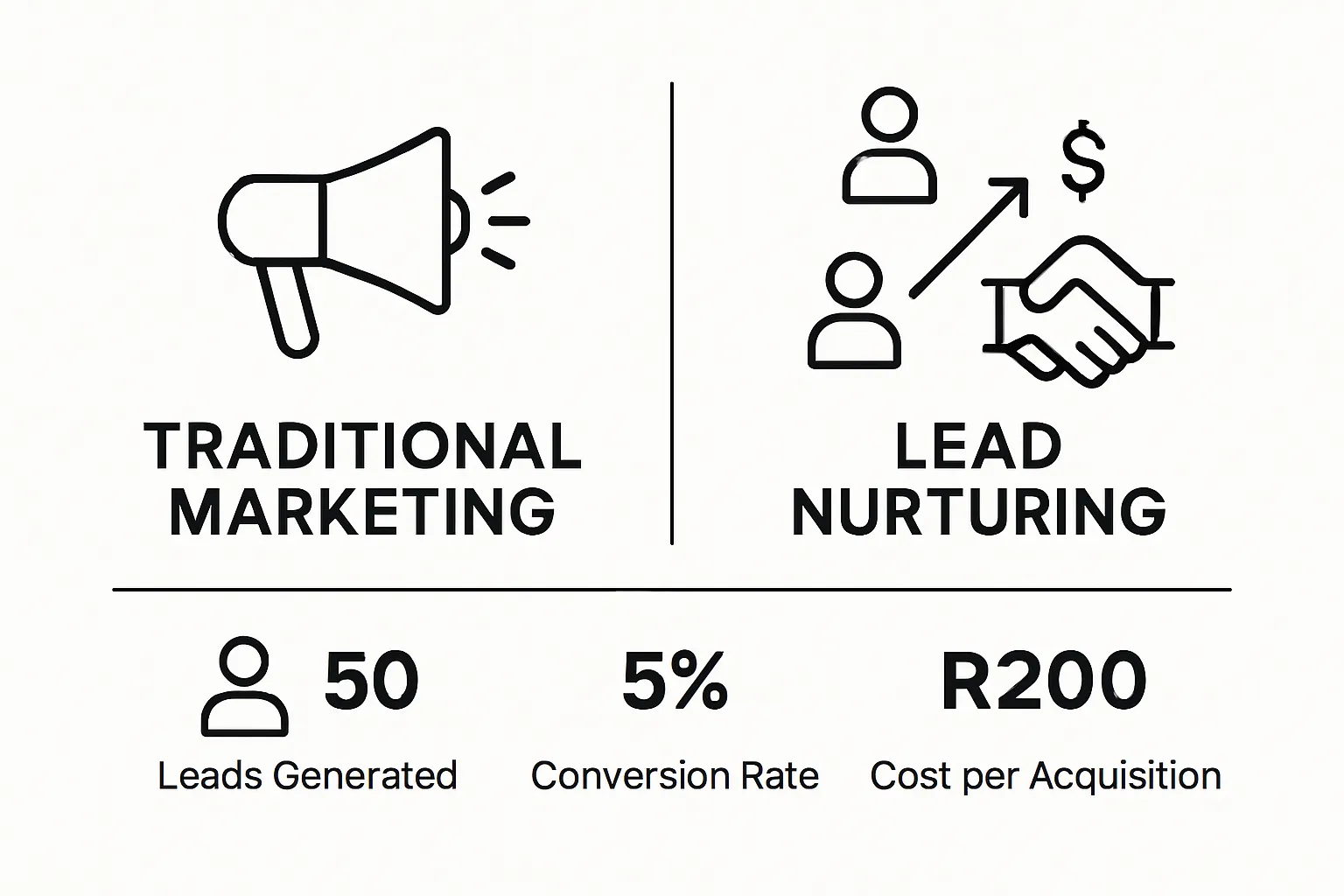Many businesses pour thousands into marketing, hoping to capture new customers with every campaign. But the reality looks very different. Companies that excel at lead nurturing generate 50 percent more sales-ready leads at 33 percent lower cost. Most people think it is all about blasting messages or chasing instant sales. What actually makes the real impact is building genuine connections that move potential customers step by step closer to buying.
Table of Contents
- Defining Lead Nurturing: The Basics Explained
- The Importance Of Lead Nurturing In Digital Marketing
- How Lead Nurturing Works: Key Processes Involved
- The Role Of Content In Lead Nurturing
- Measuring The Success Of Lead Nurturing Efforts
Quick Summary
| Takeaway | Explanation |
|---|---|
| Lead nurturing builds lasting customer relationships. | This strategy focuses on developing trust and engagement instead of pushing for immediate sales. |
| Personalisation enhances communication effectiveness. | Tailoring messages to individual prospects increases the likelihood of engagement and conversion. |
| Multichannel approaches improve outreach success. | Utilizing various platforms like email and social media ensures broader engagement with potential customers. |
| Content quality is crucial for effective nurturing. | Providing valuable, relevant content addresses customer pain points and fosters trust in your brand. |
| Regular measurement optimizes lead nurturing efforts. | Tracking metrics like conversion rates helps refine strategies, ensuring continuous improvement in customer engagement. |
Defining Lead Nurturing: The Basics Explained
Lead nurturing represents a strategic marketing approach focused on developing and strengthening relationships with potential customers throughout their buying journey. At its core, lead nurturing goes beyond simple contact management and transforms initial interest into meaningful engagement that ultimately drives sales conversions.
What Exactly is Lead Nurturing?
Lead nurturing is a systematic process of engaging potential customers by providing relevant, personalised information that addresses their specific needs, challenges, and interests. Rather than applying a one-size-fits-all approach, this strategy involves understanding each potential customer’s unique position in the purchasing decision and delivering targeted communication accordingly.
According to Hubspot’s Marketing Research, organisations that excel at lead nurturing generate 50% more sales-ready leads at a 33% lower cost. This statistic underscores the critical importance of a well-designed lead nurturing strategy.
Key Components of Effective Lead Nurturing
Successful lead nurturing involves several essential components that work together to create a compelling customer experience:
- Personalisation: Tailoring communication and content to match individual prospect preferences
- Timely Engagement: Reaching out to potential customers at the right moment in their decision making process
- Multichannel Approach: Utilising various communication channels like email, social media, and targeted content
By implementing these strategic elements, businesses can transform potential leads into committed customers, creating a more meaningful and profitable marketing approach that focuses on building genuine connections rather than simply pushing for immediate sales.
Below is a breakdown of the essential components that contribute to a successful lead nurturing strategy for businesses aiming to build long-term customer relationships.
| Component | Description |
|---|---|
| Personalisation | Tailoring communication and content based on individual prospect preferences |
| Timely Engagement | Reaching out at the right moment in the decision-making process |
| Multichannel Approach | Using multiple channels like email, social media, and targeted content to reach prospects |
| Content Quality | Providing valuable, relevant content to address customer pain points |
| Continuous Measurement | Regularly tracking metrics and refining strategies for better results |
The Importance of Lead Nurturing in Digital Marketing
In the competitive digital marketing landscape, lead nurturing has emerged as a critical strategy for businesses seeking sustainable growth and customer engagement. Unlike traditional marketing approaches that focus solely on immediate sales, lead nurturing recognizes that potential customers require carefully cultivated relationships before making purchasing decisions.
Why Lead Nurturing Matters for Business Success
Lead nurturing represents a strategic investment in building long-term customer relationships. According to Content Marketing Institute, most leads are not immediately ready to purchase, making continuous engagement crucial for converting potential interest into actual sales. By providing consistent, targeted communication, businesses can guide prospects through their buying journey more effectively.

Transforming Potential into Profitable Relationships
Effective lead nurturing offers significant business advantages:
- Cost Efficiency: Reduces customer acquisition costs by focusing on warming up existing leads
- Higher Conversion Rates: Increases the likelihood of turning prospects into paying customers
- Customer Loyalty: Builds trust and demonstrates genuine understanding of customer needs
For small businesses looking to optimize their digital marketing efforts, understanding lead generation strategies becomes essential. The goal is not just capturing leads but developing meaningful connections that translate into sustainable business growth.
By implementing a robust lead nurturing approach, businesses can create a more predictable sales pipeline, improve customer engagement, and ultimately drive revenue more strategically and efficiently.

How Lead Nurturing Works: Key Processes Involved
Lead nurturing operates as a strategic, data-driven process that transforms potential customer interactions into meaningful engagement pathways. By understanding and implementing specific methodological approaches, businesses can effectively guide prospects through their purchasing journey.
Segmentation and Targeting
The foundational process of lead nurturing begins with precise audience segmentation. According to Research Gate, categorizing leads based on their behavior, interests, and engagement levels allows for hyper-personalized communication. This approach ensures that each potential customer receives relevant content tailored to their specific stage in the buying process.
Content and Communication Strategies
Successful lead nurturing involves creating a comprehensive communication strategy that addresses different customer touchpoints. Businesses must develop a multi-channel approach that includes:
- Email Marketing: Sending targeted, personalized email sequences
- Content Mapping: Creating specific content for each buyer journey stage
- Automated Workflows: Designing intelligent communication triggers
By mastering lead scoring best practices, organisations can refine their approach and prioritize leads with the highest conversion potential.
Ultimately, lead nurturing is about building genuine relationships, understanding customer needs, and providing consistent value throughout their decision-making process. By implementing these strategic processes, businesses can transform potential leads into loyal, committed customers.
The Role of Content in Lead Nurturing
Content serves as the critical communication bridge between businesses and potential customers throughout the lead nurturing process. It provides the essential context, education, and value that transforms casual interest into genuine engagement and eventual conversion.
Creating Targeted and Valuable Content
Effective lead nurturing content goes far beyond generic marketing materials. According to Content Marketing Institute, strategic content must address specific customer pain points and demonstrate a deep understanding of their unique challenges and needs. By developing highly relevant and personalized content, businesses can build trust and credibility with potential leads.
Content Types and Their Strategic Purpose
Successful lead nurturing requires a diverse content approach that supports different stages of the customer journey:
- Educational Content: Blog posts, whitepapers, and guides that provide valuable insights
- Social Proof: Case studies and testimonials that validate business capabilities
- Interactive Content: Webinars, quizzes, and assessments that encourage prospect engagement
Understanding why content marketing matters becomes crucial for businesses seeking to develop meaningful connections with potential customers. The right content not only informs but also builds emotional resonance and positions a brand as a trusted industry expert.
Ultimately, content in lead nurturing is about creating a narrative that guides prospects through their decision-making journey, providing value at every touchpoint and demonstrating the unique solutions a business can offer.
Measuring the Success of Lead Nurturing Efforts
Measuring lead nurturing effectiveness requires a strategic approach that goes beyond simple metrics. Businesses must develop a comprehensive framework for tracking and analyzing the performance of their lead nurturing campaigns to ensure continuous improvement and meaningful results.
Key Performance Indicators for Lead Nurturing
Successful lead nurturing measurement involves tracking multiple interconnected metrics that provide a holistic view of performance. According to recent marketing research, conversion rates and engagement levels are critical indicators of lead nurturing effectiveness. These metrics help businesses understand how well their strategies are transforming potential leads into committed customers.
Essential Metrics to Track
Comprehensive lead nurturing performance evaluation includes monitoring several crucial metrics:
- Conversion Rate: Percentage of leads successfully moving through the sales funnel
- Engagement Score: Measuring interaction levels with nurturing content
- Sales Cycle Length: Time required to convert a lead into a customer
- Return on Investment (ROI): Financial performance of nurturing campaigns
Exploring marketing analytics for small businesses becomes crucial for understanding these complex measurement strategies. By implementing robust tracking mechanisms, businesses can gain actionable insights that drive continuous improvement in their lead nurturing approaches.
Ultimately, successful lead nurturing measurement is about creating a dynamic, data-driven process that allows businesses to adapt, refine, and optimize their customer engagement strategies continuously.
The following table summarises key metrics and indicators that help businesses measure the effectiveness of their lead nurturing efforts throughout the customer journey.
| Metric | What It Measures | Strategic Value |
|---|---|---|
| Conversion Rate | Percentage of leads moving through the sales funnel | Indicates campaign effectiveness |
| Engagement Score | The level of interaction with nurturing content | Shows how engaged leads are with your content |
| Sales Cycle Length | Time taken to convert a lead to a customer | Assesses process efficiency and speed |
| Return on Investment (ROI) | The financial performance of nurturing campaigns | Evaluates cost-effectiveness |
Transform Your Lead Nurturing Into Measurable Growth
Are you struggling to bridge the gap between initial interest and real sales? Many businesses find that simply capturing leads is not enough—consistent engagement and tailored communication are what truly move potential customers through the sales funnel. If you want to boost conversion rates and lower customer acquisition costs, it’s time to put your data to work.

Partner with Zoo Digital to unlock powerful lead nurturing strategies grounded in data-driven insights. Our team specialises in everything from tracking implementation and Hubspot CRM management to smart ad campaigns and automated workflows. Let us help you craft content and follow-up paths that deliver value at every touchpoint. Ready to start converting more leads and creating loyal customers? Visit our homepage for a closer look at our solutions and book your consultation today.
Frequently Asked Questions
What is lead nurturing?
Lead nurturing is a strategic marketing approach focused on developing and strengthening relationships with potential customers throughout their buying journey, transforming initial interest into meaningful engagement.
Why is lead nurturing important for businesses?
Lead nurturing helps build long-term customer relationships, increases the likelihood of turning prospects into paying customers, and ultimately reduces customer acquisition costs.
How does effective lead nurturing improve conversion rates?
By providing targeted communication and personalized content, businesses can better guide prospects through their buying journey, which increases the chances of converting leads into sales.
What types of content are effective in lead nurturing?
Effective content types for lead nurturing include educational materials like blog posts and whitepapers, social proof such as case studies and testimonials, and interactive content like webinars and quizzes.

